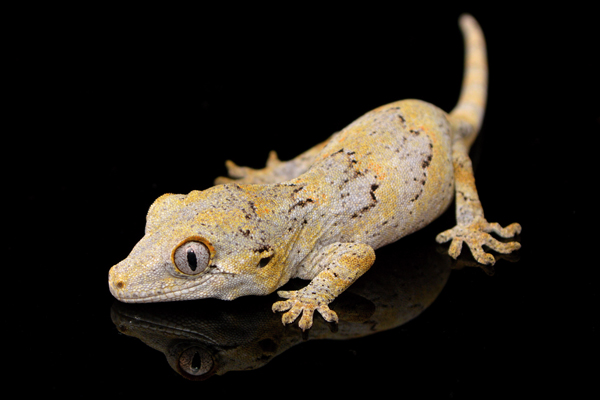A Gecko is a small lizard that belongs to the ‘Gekkota’ family. This family includes ‘snake-lizards’ as well as all the geckos. Gargoyle Gecko is one of the species of gecko which was found only in the southern end of the New Caledonia Island (a group of island between Fiji and Australia) and hence is also known as ‘New Caledonian Bumpy Gecko’. This gecko was first discovered by Bavay in 1869. However, there is extensive deforestation in the island which poses a threat to their habitat. They were once considered very rare but nowadays, gargoyle geckos are bred in huge numbers and are one of the most common reptiles in captivity.
Structure & Appearance

Gargoyle Geckos grow to a moderate size of 8 inches in total and around 4 to 4.5 inches when measured from snout to vent (SVL) and weigh around 60 grams. They come in a variety of colours and patterns, like shades of gray, white, brown, yellow, red and orange. Patterns do vary but stripes, bands and mottling are common. These geckos have cranial bumps that give the appearance of horns. They display bulges at the base of the tail. However, in case of males, the bulges are larger and males also have femoral pores on scale in between their hind legs. Similar to other lizards, they also have a prehensile tail which grows again after it drops off. Dropping of the tail is a very common condition for adult geckos and they end up with a tiny pointed tail nub.
Gargoyle Gecko in Captivity

Gargoyle Geckos have become very successful in captivity and are readily available. It is important that a gecko in captivity is properly taken care of. Several factors like diet, environment, breeding, lighting, temperature, humidity etc are there to consider in making the gecko a healthy one.
Food & Diet: Generally, these geckos have fruit mashes, fruit and powdered diet. The ‘Crested Gecko Diet’ offered by ‘Repashy Super foods’ is a market leader in this section as this excludes the need to feed them with live insects. This has been tested for over 10 years and gargoyle geckos thrive when given this diet. Alternatively, these geckos could be occasionally given crickets and wax worms loaded with calcium and vitamin D3.
Housing: A baby gargoyle can be kept in a 10 gallon tank but for a mature one, a 20 gallon tank would be needed. Geckos also appreciate some height in their environment and hence we should consider this while planning for its housing.
Substrate: Although, this is a part of housing, it deserves a separate mention as gargoyle geckos spend time on the ground. For easy maintenance, a reptile carpet maybe used. Also, Coco Fibre mixed with peat moss can be used. Gargoyle Geckos are avid climbers and hence would like tall, live or artificial plants along with wood and bark.
Temperature & Humidity: Being from a subtropical climate, these geckos like temperatures around 76 to 80 degrees Fahrenheit. In summers, these geckos should be kept in a cool room if temperature exceeds 85 degrees. Whereas, in winters, they should be given additional heat if temperature falls below the 60s. Moving on to humidity levels, 60 to 70% is considered to be good. One must take care in keeping these geckos well hydrated so that they are able to shed their skin. Giving them clean water in a reptile water bowl would help keep their ideal humidity levels.
Breeding: Gargoyle Geckos generally breed from December to August during which the female lays two eggs per clutch, which hatch around 60 to 90 days later. The female can lay around 8 to 9 clutches in a year. It is important to note that geckos of the same sex shouldn’t be kept together as they indulge in territory related clashes and hurt each other. Also, after the breeding season, it is recommended to remove the males and let the females recover.
Gargoyle Geckos are a great pet if properly taken care of. Under proper are, they go on to live for around 15 to 20 years. It is important that we allow them to adjust themselves with the new environment and thus should not be handled immediately after bringing them home. Slowly and gradually they should be handled that too in short sessions. Once the gecko adapts itself to the new environment, it can be handled over a cushioned surface. Gargoyle Geckos are amazing lizards in captivity and every effort should be made to make it feel comfortable.













